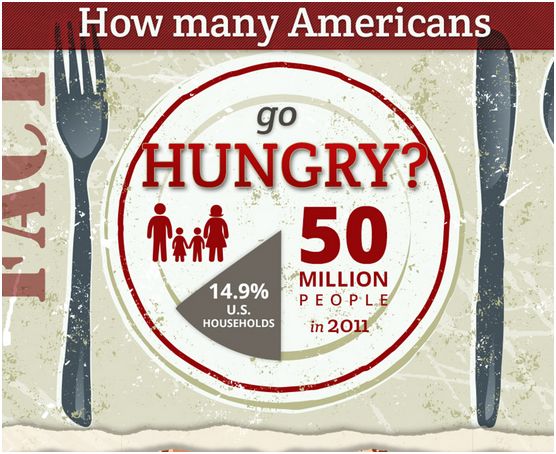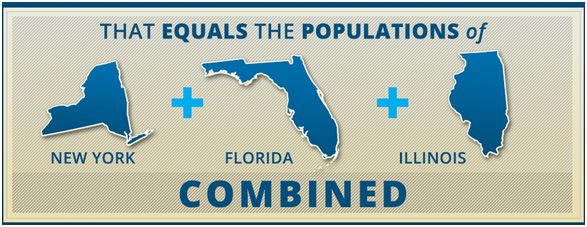This congress has adopted nearly $5 billion in cuts to SNAP and food stamps when nearly 47 million Americans rely on these programs. Their reasoning is that is what they have determined is the amount that is fraud and abuse. However, A USDA study contradicts those findings and determined that there is less than 1% in fraud and abuse in these programs. This congress has also failed to act on the farm bill which could lead to milk prices climbing to as high as $7 or $8 per gallon. We can bail out banksters to the excess of $15 trillion dollars, but to hell with whether our people eat? Really is this what we have allowed our government to become. Food insecurity in the US is at its worst levels since the depression, which co-incidently was another crisis caused by greedy banksters. The really scary difference between now and then is that then we still had a congress, while influenced by money, wasn’t OWNED by monied interest.
Even during the recessions of the 60’s and 70s food insecurity was a topic in the US most associated with Africa, India, and China. However, since 2008 food insecurity has become a serious issue for western countries such as the US and Britain. Income inequality has finally reached into our bellies.
In the United States, more than one out of five children lives in a household with food insecurity, which means they do not always know where they will find their next meal. According to the United States Department of Agriculture (USDA), 16.7 million children under 18 in the United States live in this condition – unable to consistently access nutritious and adequate amounts of food necessary for a healthy life. In 2009, the top five states with the highest rate of food insecure children under 18 are the District of Columbia, Oregon, Arizona, Arkansas, & Texas. 20% or more of the child population in 40 states and D.C. lived in food insecure households in 2009.
Here is a snapshot:
United States 14.7%
Mississippi 20.9%
Arkansas 19.7%
Texas 18.4%
Alabama 17.9%
North Carolina 17.0%
Georgia 16.9%
Missouri 16.7%
Nevada 16.6%
Ohio 16.1%
California 15.6%
In 2012, 85.5 percent of U.S. households were food secure throughout the year. The remaining 14.5 percent (17.6 million households) were food insecure. Food-insecure households (those with low and very low food security) had difficulty at some time during the year providing enough food for all their members due to a lack of resources. In 2012, 5.7 percent of U.S. households (7.0 million households) had very low food security. In this more severe range of food insecurity, the food intake of some household members was reduced and normal eating patterns were disrupted at times during the year due to limited resources. Children were food insecure at times during the year in 10.0 percent of households with children. That’s 1 in 10 children in the US. These 3.9 million households were unable at times during the year to provide adequate, nutritious food for their children.
Do rises in food prices affect food insecurity? Here are some recent findings:
- Overall, local food prices “significantly” affect food insecurity for those households at 200% or less of the poverty line: “Those in the highest-priced areas are significantly more likely to be food insecure: Households in high-priced areas are 8.6, 8.3, and 10.0 percentage points more likely to experience household, adult and child food insecurity, respectively, compared to those in low-priced areas.”
- The data suggest that “SNAP has large and significant effects on the probability of food insecurity for participants: SNAP reduces the probability of household, adult, and child food insecurity by 17.4, 11.2 and 20.6 percentage points, which amount to reductions of 33.7%, 24.6% and 70.3% of prevalence for these populations.”
- In addition, “SNAP households that live in the places with the highest quartile of food prices are between 8 and 10 percentage points (between 15% and 20%) more likely to be food insecure than those in the lowest quartile of food prices.”
Hunger in Britain has reached the level of a “public health emergency” and the Government may be covering up the extent to which austerity and welfare cuts are adding to the problem, leading experts have said.
In a letter to the British Medical Journal, a group of doctors and senior academics from the Medical Research Council and two leading universities said that the effect of Government policies on vulnerable people’s ability to afford food needed to be “urgently” monitored.
A surge in the number of people requiring emergency food aid, a decrease in the amount of calories consumed by British families, and a doubling of the number of malnutrition cases seen at English hospitals represent “all the signs of a public health emergency that could go unrecognized until it is too late to take preventative action,” they write.
Despite mounting evidence for a growing food poverty crisis in the UK, ministers maintain there is “no robust evidence” of a link between sweeping welfare reforms and a rise in the use of food banks. However, publication of research into the phenomenon, commissioned by the Government itself, has been delayed, amid speculation that the findings may prove embarrassing for ministers.
“Because the Government has delayed the publication of research it commissioned into the rise of emergency food aid in the UK, we can only speculate that the cause is related to the rising cost of living and increasingly austere welfare reforms,” the public health experts write.
The authors of the letter, who include Dr David Taylor-Robinson and Professor Margaret Whitehead of Liverpool University’s Department of Public Health, say that malnutrition can have a long-lasting impact on health, particularly among children.
Chris Mould, chief executive of the Trussell Trust, the largest national food bank provider said that one in three of the 350,000 people who required a food bank hand-out this year were children. He called the BMJ letter a “timely warning” and criticized the Department of Work and Pensions (DWP) for keeping its report into the problem “under wraps”. The report was commissioned by the Department for Environment Food and Rural Affairs (Defra) in February, and was completed by an academic at Warwick University. However, publication has been stalled.
“We’ve sought to engage with the DWP in order to share our data and share our experience, with a view to exploring what practical action could be taken to ease the problem,” Mr Mould told The Independent. “We’ve had refusals, letters saying they do not want to talk to us. We find that deeply disappointing.”
“We want to see that research. It was commissioned by Government, pulled together by a highly reputable academic and we want to see what it says. We understand that the reason it has not been published is that DWP has queried aspects of the data in it and has been preventing its publication for months. That, we think, is not acceptable.”
“Malnutrition in children is particularly worrying because exposures during sensitive periods can have lifelong effects, increasing the risk of cardiovascular diseases and other adult chronic diseases,” they write. “Access to an adequate food supply is the most basic of human needs and rights.”
But Luciana Berger, Labour’s shadow minister for public health, said that it was a “national scandal” that people were suffering from malnutrition in the UK. “This shouldn’t be happening in 21st century Britain,” she said. “With hundreds of thousands having to access emergency food aid, it’s sadly unsurprising that people are both eating less and eating less healthily. David Cameron needs to listen to what the experts are saying and tackle the cost of living crisis driving people into food poverty.” “I don’t think this is acceptable in the seventh richest country in the world – and I’d really like to know the reasons why it’s happening so we can stop it…” she said. “We need to stop turning a blind eye.”
Well it is even more unacceptable in the richest country in the world. I think our congressmen and women should think long and hard about what they are doing to play favor to the oligarchs at our expense. They would do well to remember the infamous words of Marie Antoinette when she said, “Let them eat cake!” We all know what happened to dear sweet Marie. However, we also need to look into the mirror and ask one simple question: “why am I allowing this to happen and I am staying silent?” Well do you have an answer for yourself?




About 10 to 12 years ago I remember talking to some friends at work and remarked that we had not yet came to the point in the U.S. where we were willing to let people starve.
What progress we have made in 10 years!!
Letting people starve is just fine now, but let a Bankster loose a few Billion dollars because they committed fraud and we all jump to make sure the Banksters get bailed out
Yes what progress we have made.
How sadly true, Captain. My question is when are we going to finally get pissed off enough to actually do something about it?